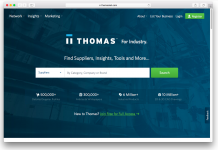Businesses are always looking for ways to grow and improve, whether that’s through their bottom line or through the people they hire. Lately, companies have been discovering the bottom line benefits of diversifying their staff, but have you ever thought about people with disabilities as a key diversity group to consider?
Tangram Business Resourcing (TBR), an organization based in Indianapolis, Ind. dedicated to disability inclusion, provides businesses with the tools to understand, recruit, employ and retain people with disabilities.
Companies experience several positive outcomes when they expand their disability inclusion strategies, like improved productivity, company culture and overall morale. However, before these strategies can be effective, businesses need to fully understand what a disability is and the history behind these individuals’ job opportunities. TBR works with companies to ensure that they are connected to local resources to effectively meet these goals.
What is “disability?”
In order for businesses to successfully integrate this segment of the population into their workforce, they need to know all the facts. Under the Americans with Disability Act (ADA), a person has a disability if they have at least one of the following:
- A physical or mental condition that substantially limits one or more major life activities;
- A history of such a condition; or
- A person is believed to have a physical or mental impairment that is not transitory and minor.
Disability cannot be put into one box. No two disabilities are alike, and no two people with the same disability experience it the same way. For instance, many disabilities can impact different physical or intellectual functions depending on the person, like autism and multiple sclerosis. Employers cannot assume people with a certain disability are better suited for a specific job because someone else with the same disability has previously done well with that type of work.
History of disability inclusion
Businesses have been hiring people with disabilities for years, but the approaches have changed over the course of time, as the value of hiring people with disabilities has increased. There was a gradual shift from sheltered workshops to supported employment in the 1980s and a person-centered focus in the 1990s. These shifts focused more on the needs of the individual and less about the needs of the business, creating unsuitable employment matches. Today, we now see a trend in corporate disability inclusion. This focuses more on the needs of the businesses and creates better employment matches, ones that work for both the employer and the employee.
Randy Lewis, the former senior vice president of logistics and distribution for Walgreens, conducted a great example of corporate disability inclusion. His own personal experiences with disability inspired him to initiate a large-scale disability inclusion initiative for the company. Walgreens developed the “same job, same performance” model that spread across retail stores, distribution centers, support centers, and field operations. This strategy was built around the idea that all jobs and expectations are the same for every employee, regardless of disability, and all employees were held to the same standard for the same amount of pay. As a result, a study on this business model conducted by the American Society of Safety Engineers determined that employees with disabilities had a lower turnover rate than those without disabilities, along with lower medical costs and time-off expenses.
Although Walgreens might have been a pioneer in disability inclusion, many companies have been working to develop similar inclusion strategies. Some of these companies might want to diversify their staff, but they lack the tools to do so. This is where TBR comes in. TBR works with businesses to create these opportunities for people with disabilities, providing companies with access to a larger (and very qualified) candidate pool.
The facts behind the data
People with disabilities represent the largest minority in the U.S., with one of every five people in the U.S. living with a disability. However, these individuals are consistently experiencing a higher unemployment rate compared to those without disabilities. In November of 2017, the unemployment rate for people with disabilities was 8.5 percent and the rate for people without disabilities was 3.7 percent. People with disabilities are often as qualified or more qualified than those without disabilities.
Nearly 80 percent of people with disabilities had graduated from high school, 2.5 percent had a college or associate’s degree, and 16.4 percent had a bachelor’s degree or higher. On the flip side, 90 percent of people without disabilities had graduated from high school, 26.8 percent had a college or associate’s degree, and 34.6 percent had a bachelor’s degree or higher, according to the U.S. Department of Labor.
As an added benefit, a 2007 study conducted by DePaul University found that people with disabilities stay on the job longer than individuals without disabilities. And if businesses are worried about the added costs associated with hiring people with disabilities, they shouldn’t be. The Job Accommodation Network found that most employers report no cost or low cost for accommodating employees with disabilities.
The benefits of disability inclusion in a company are substantial, but some businesses might not know where to start on their journey to diversify their staff. Organizations like TBR can support organizations in meeting their business goals while also integrating diverse sources of talent from individuals with disabilities, which can help both businesses and people with disabilities reach their highest goals.
Find a Home-Based Business to Start-Up >>> Hundreds of Business Listings.

















































